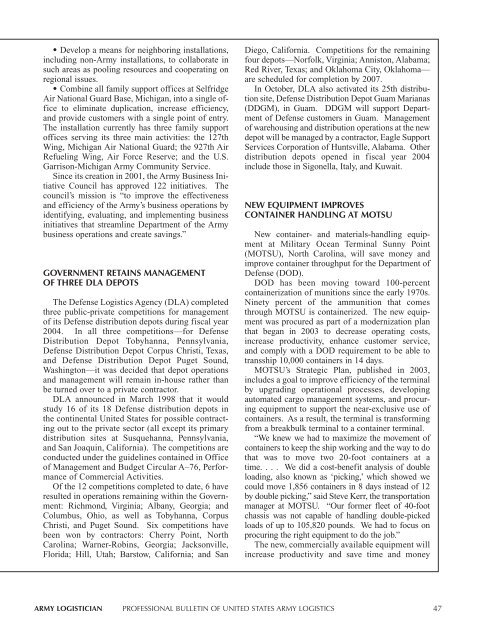Life-Cycle Management - Army Logistics University - U.S. Army
Life-Cycle Management - Army Logistics University - U.S. Army
Life-Cycle Management - Army Logistics University - U.S. Army
You also want an ePaper? Increase the reach of your titles
YUMPU automatically turns print PDFs into web optimized ePapers that Google loves.
• Develop a means for neighboring installations,<br />
including non-<strong>Army</strong> installations, to collaborate in<br />
such areas as pooling resources and cooperating on<br />
regional issues.<br />
• Combine all family support offices at Selfridge<br />
Air National Guard Base, Michigan, into a single office<br />
to eliminate duplication, increase efficiency,<br />
and provide customers with a single point of entry.<br />
The installation currently has three family support<br />
offices serving its three main activities: the 127th<br />
Wing, Michigan Air National Guard; the 927th Air<br />
Refueling Wing, Air Force Reserve; and the U.S.<br />
Garrison-Michigan <strong>Army</strong> Community Service.<br />
Since its creation in 2001, the <strong>Army</strong> Business Initiative<br />
Council has approved 122 initiatives. The<br />
council’s mission is “to improve the effectiveness<br />
and efficiency of the <strong>Army</strong>’s business operations by<br />
identifying, evaluating, and implementing business<br />
initiatives that streamline Department of the <strong>Army</strong><br />
business operations and create savings.”<br />
GOVERNMENT RETAINS MANAGEMENT<br />
OF THREE DLA DEPOTS<br />
The Defense <strong>Logistics</strong> Agency (DLA) completed<br />
three public-private competitions for management<br />
of its Defense distribution depots during fiscal year<br />
2004. In all three competitions—for Defense<br />
Distribution Depot Tobyhanna, Pennsylvania,<br />
Defense Distribution Depot Corpus Christi, Texas,<br />
and Defense Distribution Depot Puget Sound,<br />
Washington—it was decided that depot operations<br />
and management will remain in-house rather than<br />
be turned over to a private contractor.<br />
DLA announced in March 1998 that it would<br />
study 16 of its 18 Defense distribution depots in<br />
the continental United States for possible contracting<br />
out to the private sector (all except its primary<br />
distribution sites at Susquehanna, Pennsylvania,<br />
and San Joaquin, California). The competitions are<br />
conducted under the guidelines contained in Office<br />
of <strong>Management</strong> and Budget Circular A–76, Performance<br />
of Commercial Activities.<br />
Of the 12 competitions completed to date, 6 have<br />
resulted in operations remaining within the Government:<br />
Richmond, Virginia; Albany, Georgia; and<br />
Columbus, Ohio, as well as Tobyhanna, Corpus<br />
Christi, and Puget Sound. Six competitions have<br />
been won by contractors: Cherry Point, North<br />
Carolina; Warner-Robins, Georgia; Jacksonville,<br />
Florida; Hill, Utah; Barstow, California; and San<br />
Diego, California. Competitions for the remaining<br />
four depots—Norfolk, Virginia; Anniston, Alabama;<br />
Red River, Texas; and Oklahoma City, Oklahoma—<br />
are scheduled for completion by 2007.<br />
In October, DLA also activated its 25th distribution<br />
site, Defense Distribution Depot Guam Marianas<br />
(DDGM), in Guam. DDGM will support Department<br />
of Defense customers in Guam. <strong>Management</strong><br />
of warehousing and distribution operations at the new<br />
depot will be managed by a contractor, Eagle Support<br />
Services Corporation of Huntsville, Alabama. Other<br />
distribution depots opened in fiscal year 2004<br />
include those in Sigonella, Italy, and Kuwait.<br />
NEW EQUIPMENT IMPROVES<br />
CONTAINER HANDLING AT MOTSU<br />
New container- and materials-handling equipment<br />
at Military Ocean Terminal Sunny Point<br />
(MOTSU), North Carolina, will save money and<br />
improve container throughput for the Department of<br />
Defense (DOD).<br />
DOD has been moving toward 100-percent<br />
containerization of munitions since the early 1970s.<br />
Ninety percent of the ammunition that comes<br />
through MOTSU is containerized. The new equipment<br />
was procured as part of a modernization plan<br />
that began in 2003 to decrease operating costs,<br />
increase productivity, enhance customer service,<br />
and comply with a DOD requirement to be able to<br />
transship 10,000 containers in 14 days.<br />
MOTSU’s Strategic Plan, published in 2003,<br />
includes a goal to improve efficiency of the terminal<br />
by upgrading operational processes, developing<br />
automated cargo management systems, and procuring<br />
equipment to support the near-exclusive use of<br />
containers. As a result, the terminal is transforming<br />
from a breakbulk terminal to a container terminal.<br />
“We knew we had to maximize the movement of<br />
containers to keep the ship working and the way to do<br />
that was to move two 20-foot containers at a<br />
time. . . . We did a cost-benefit analysis of double<br />
loading, also known as ‘picking,’ which showed we<br />
could move 1,856 containers in 8 days instead of 12<br />
by double picking,” said Steve Kerr, the transportation<br />
manager at MOTSU. “Our former fleet of 40-foot<br />
chassis was not capable of handling double-picked<br />
loads of up to 105,820 pounds. We had to focus on<br />
procuring the right equipment to do the job.”<br />
The new, commercially available equipment will<br />
increase productivity and save time and money<br />
ARMY LOGISTICIAN PROFESSIONAL BULLETIN OF UNITED STATES ARMY LOGISTICS 47







